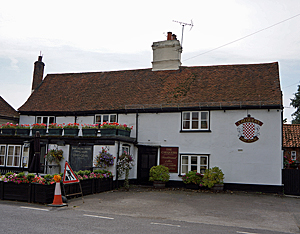


George and Dragon, 294 Roman Road, Mountnessing CM15
In lease documents before 1800, the George and Dragon was previously known as the George Inn or St George Inn. The George Inn during the 18th century was owned by Lord Petre of Ingatestone.
Barnaby Wood was its Victualler between 1786 and 1806 when he died, as clarified by his Will and lease documents. We can surmise that Lord Petre converted an existing building into a Pub in 1769, when the George Inn received its first license. The Victuallers of the George Inn preceding Barnaby were Thomas Price (1769-1782), Mary Price (1782-1784), and William Gate (1784-1786).
The Essex Pub History website states that Edmund Fletcher was the licensee of the George Inn between 1802 and 1804, followed by Robert Barker between (1804 and 1810), then followed by Elizabeth Barker (1810-1812). If true, perhaps Barnaby during the last years of his life subleased the property to Fletcher and Barker. Barker is a surname connected to Barnaby’s family. After the Barkers the licensees were George Frost (1812-1813), and then William Coverdale (1813-1815). Members of the Coverdale family were employed by Lord Petre.

The Griffin, 64 Main Road, Danbury CM3 4DH
According to the register of Historic England, the main house of The Griffin dates soon after 1500 and was originally named Peppers. When the house was converted into a pub in 1744, it was renamed The Griffin’s Head. Sir Walter Scott mentions The Griffin in the introduction to Waverly, his first novel published in 1814.
We can prove Joseph Myall of Castle Hedingham owned the Griffin between 1781 and 1793 when he died. The Myall family likely owned the Griffin prior to 1781. Joseph Wiffen, the brother-in-law of Joseph Myall, was the Victualler between 1781-1786, when he relocated to Latchingdon to become the Victualler of the Red Lion. Thomas Bacon, who previously was the Victualler of the Lion in Weathersfield, followed Joseph as the Victualler of The Griffin in 1787. We can prove the Thomas Bacon remained its Victualer until 1793 but suppose he continued afterwards.
The 1813 Deed of separation between Samuel Bawtree of Colchester, Esquire, and his wife Elizabeth indicates that they owned the The Griffin, previously known as Peppers. (D/DTo F9). Samuel Bawtree was the son-in-law of Joseph Myall, forcing the conclusion that Samuel and Elizabeth owned the Griffin between 1793 and 1813.

Chequers, at The Street, Roxwell
The Chequers is built on a parcel called Broadgates, dating back to a manorial survey in 1566. The building is timber-framed and plastered construction, which was built by the Perry family. When Christopher Perry died in 1673 his estate included the “malthouse and granary, and brewing vessels in the Bruehouse” (Roxwell Revealed, page 59). In about 1770 the Bruehouse was renamed The Chequers.
Thomas Wiffin was its Victualler from 1781 until his death in 1786, followed by Jane Wiffen, his widow. The Victuallers before Thomas Wiffen were Thomas Milbank (1770), Thomas Milbank and William Piores (1772), and John Carter (1778). The Victuallers after Jane Wiffen were Richard Palmer (1789) and then John Beard of Margaretting (1794-1814). John Beard married Mary Allen in 1769. The widow of Christopher Perry married Edward Allen. When John became the Victualler, the management of the Chequers returned to the Perry/Allen family.
We do not know what you know. Please share with us your knowledge, and help us correct any error you find in our research.